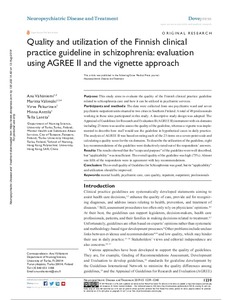Quality and utilization of the Finnish clinical practice guideline in schizophrenia: evaluation using AGREE II and the vignette approach
Vähäniemi A; Välimäki M; Pekurinen V; Anttila M; Lantta T
Quality and utilization of the Finnish clinical practice guideline in schizophrenia: evaluation using AGREE II and the vignette approach
Vähäniemi A
Välimäki M
Pekurinen V
Anttila M
Lantta T
Julkaisun pysyvä osoite on:
https://urn.fi/URN:NBN:fi-fe2021042822405
https://urn.fi/URN:NBN:fi-fe2021042822405
Tiivistelmä
Purpose: This study aims to evaluate the quality of the Finnish clinical practice guideline related to schizophrenia care and how it can be utilized in psychiatric services.
Participants and methods: The data were collected from one psychiatric ward and seven psychiatric outpatient units situated in two cities in Southern Finland. A total of 49 professionals working in these sites participated in this study. A descriptive study design was adopted. The Appraisal of Guidelines for Research and Evaluation II (AGREE II) instrument with six domains including 23 items was used to assess the quality of the guideline, whereas a vignette was implemented to describe how staff would use the guideline in hypothetical cases in daily practice. The analysis of AGREE II was based on rating each of the 23 items on a seven-point scale and calculating a quality score for the six domains. To describe the utilization of the guideline, eight key recommendations of the guideline were deductively rated out of the respondents’ answers.
Results: The results showed that the “scope and purpose” of the guideline were well described, but “applicability” was insufficient. The overall quality of the guideline was high (73%). Almost one fifth of the respondents were in agreement with key recommendations.
Conclusion: The overall quality of Guideline for Schizophrenia was good, but its “applicability” and utilization should be improved.
Participants and methods: The data were collected from one psychiatric ward and seven psychiatric outpatient units situated in two cities in Southern Finland. A total of 49 professionals working in these sites participated in this study. A descriptive study design was adopted. The Appraisal of Guidelines for Research and Evaluation II (AGREE II) instrument with six domains including 23 items was used to assess the quality of the guideline, whereas a vignette was implemented to describe how staff would use the guideline in hypothetical cases in daily practice. The analysis of AGREE II was based on rating each of the 23 items on a seven-point scale and calculating a quality score for the six domains. To describe the utilization of the guideline, eight key recommendations of the guideline were deductively rated out of the respondents’ answers.
Results: The results showed that the “scope and purpose” of the guideline were well described, but “applicability” was insufficient. The overall quality of the guideline was high (73%). Almost one fifth of the respondents were in agreement with key recommendations.
Conclusion: The overall quality of Guideline for Schizophrenia was good, but its “applicability” and utilization should be improved.
Kokoelmat
- Rinnakkaistallenteet [27094]
